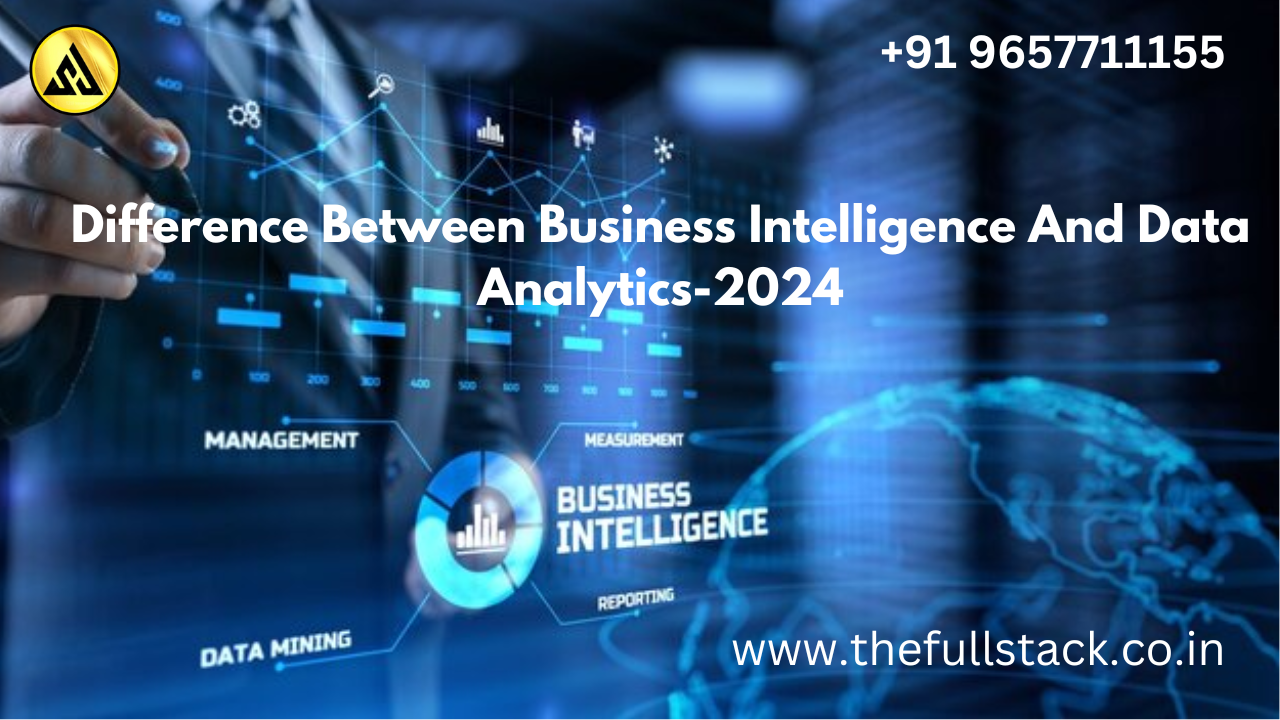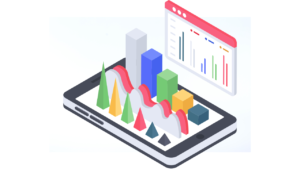
Difference Between Business Intelligence And Data Analytics-2024
The terms “business intelligence” and “data analytics” are no new to you. Right? It’s very common for people to use them interchangeably, leading to big confusion. Question arises– are they genuinely the same, or is there a difference between them? The simplest answer is that they are not exactly the same, although they do share several similarities.
In this article, we’ll introduce the concepts of business intelligence and data analytics and then see the difference between business intelligence and data analytics. Meanwhile, if you are looking for a course that can teach you both, the Mastering Full Stack Data Analytics course is the perfect solution for you!
What is Business Intelligence?

Business intelligence, in simpler terms, acts as the bridge that transforms raw data into actionable insights for businesses. These insights are like the compass guiding strategic, tactical, and day-to-day decisions.
Business intelligence has two main meanings. First, it refers to the methods, technologies, and tools companies use to uncover and present these insights. Second, it describes the actual insights themselves.
This subtle distinction is important. When talking about business intelligence, it’s crucial to be clear about whether you’re discussing the process or the end results.
Now, going back to the first definition – the process of obtaining business insights – it includes a range of approaches and tools, such as:
- Real-time monitoring for up-to-the-minute information.
- Creating and sharing dashboards for visualising data.
- Comparing performance with benchmarks.
- Extracting insights from data and text through mining.
- Utilizing BI software like Power BI
- Managing and enhancing performance.
- The practice of data analytics.
While this list doesn’t cover every aspect, it highlights the diverse aspects of business intelligence.
What is Data Analytics?

Data analytics is the process of taking out valuable insights and information from available data. It uses tools like statistical analysis, machine learning algorithms, and computational methods.
There are four primary types of data analytics:
This kind of analysis summarises and visually presents historical data to provide insights into “what has happened.” It focuses on past performance, trends, and patterns.
Diagnostic analytics seeks to understand “why something happened.” It aims to identify the root causes behind trends and patterns.
Predictive analytics, relying on historical data and statistical techniques, forecasts future outcomes and answers the question, “What is likely to happen.”
-
Prescriptive Analytics:
This type of analysis guides the actions required to achieve a specific goal, addressing the question, “What should we do.” It enables businesses to make informed decisions to achieve desired outcomes.
Also read: Top 10 Data Analytics Trends to Watch Out for in 2024
Difference Business Intelligence And Data Analytics?
At first glance, business intelligence and data analytics might look similar, and it is super normal! Many people mix up these terms, so if you’re confused, you are not alone!
Let’s make the terms clear and understand how they differ from each other–
Purpose:
- Business Intelligence: It’s all about using insights to support decision-making. Business intelligence relies on actionable insights derived from data analytics.
- Data Analytics: Focuses on transforming and refining raw data into actionable insights, which serve various purposes, including business intelligence.
Time Perspective:
- Business Intelligence: Tends to look backwards, examining past data to shape future strategies.
- Data Analytics: While it does consider past patterns, it often employs this data to predict future trends (think “predictive analytics”).
Data Type:
- Business Intelligence: Relies on structured data, such as data stored in organized systems like databases or data warehouses, often used for generating reports and dashboards.
- Data Analytics: Starts with unstructured, real-time data. Data analysts work on cleaning and organizing this data before using it for analysis.
Scope:
- Business Intelligence: Focuses on high-level, big-picture questions related to an organization’s overall direction.
- Data Analytics: Tends to address specific, narrow issues or questions, like investigating why sales of a particular product are dropping despite positive reviews.
Users:
- Business Intelligence: Mostly caters to non-technical users, including leadership teams and executives.
- Data Analytics: Is typically the realm of analysts, data scientists, and computer programmers with more technical expertise.
Approach:
- Business Intelligence: Relies on clear, user-friendly dashboards and reports for conveying insights in a straightforward manner.
- Data Analytics: Dives deep into data, conducting tasks like data mining, algorithm development, modelling, and simulations to extract insights.
Granularity:
- Business Intelligence focuses on summarizing data to create high-level reports and dashboards.
- Data Analytics looks closely at individual data points or transactions to find patterns and insights. It provides a detailed understanding of data.
Focus:
- Business Intelligence: Answers specific business questions and provides direct insights for decision-making.
- Data Analytics: Explores data to find patterns and insights, often starting with open-ended questions. It uses advanced techniques like data mining and machine learning.
Data Volume:
- Business Intelligence: Works with smaller, more manageable data volumes, often focusing on current and historical data.
- Data Analytics: Deals with large data volumes, which may require specialized tools. It involves handling storage, processing, and scalability.
Technical Skills:
- Business Intelligence: Requires less specialized technical skills and uses user-friendly tools like Tableau, Power BI, or Excel for data visualization and reporting.
- Data Analytics: Demands specialized skills like data mining and programming. Data analysts use tools like R, Python, or SQL and need to be proficient in data manipulation and visualization.
Also read: 7 Affordable Business Intelligence software Programs for Data Analysis
Examples of Business Intelligence
Let’s check out some examples of Business Intelligence:
- Understanding Sales: With Business Intelligence tools, companies track and analyze sales data from different areas, products, and sales channels. This helps them figure out which products are flying off the shelves, which regions are most profitable, and where they’re getting the most bang for their marketing buck.
- Money Matters: Business Intelligence is used to whip up financial reports and real-time dashboards. This keeps businesses in the loop about their financial health, helping them spot trouble spots and take action when necessary.
- Getting to Know Customers: Businesses dive into customer data using Business Intelligence, revealing precious insights into how customers behave and what they prefer. Armed with this knowledge, they tailor their products and services to individual preferences, which keeps customers returning for more.
- Streamlining the Supply Chain: Business Intelligence keeps a close eye on the supply chain, helping companies save money and run more efficiently. It helps businesses find snags in their supply chain, manage inventory better, and speed up delivery times.
- Tracking Performance: Key performance indicators (KPIs) like productivity and quality are monitored and analysed with Business Intelligence tools. This helps companies spot areas that need improvement and take action to make things better.
- Seeing the Future: Business Intelligence tools examine past data to spot trends and patterns, helping businesses predict what’s coming. This is handy for forecasting demand, managing risks, and making proactive decisions.
- Cracking Social Media: BI tools are also put to use in the world of social media. They help companies keep an eye on customer sentiment and the latest trends. This, in turn, guides changes to marketing strategies, making customer interactions more effective.
Examples of Data Analytics
Here are examples of Data Analytics:
- Retail: Retailers employ Data Analytics to delve into customer behaviour, preferences, and trends. This helps them fine-tune product offerings, promotions, and pricing. For instance, by analysing transaction data, retailers can identify popular products and optimise store layouts to boost sales. Social media data is used to gauge customer sentiment and tailor marketing campaigns accordingly.
- Healthcare: Data Analytics has transformed healthcare by enabling providers to scrutinize patient data, leading to improved diagnosis, treatment, and outcomes. Electronic medical records (EMR) are analyzed to detect patterns that inform treatment decisions. Predictive analytics helps identify patients at risk of chronic diseases, allowing for timely intervention.
- Finance: Financial institutions employ Data Analytics to manage risk, detect fraud, and streamline operations. For instance, banks use predictive analytics to spot fraudulent transactions and prevent losses. They also analyse customer behaviour and preferences to offer personalized products and services.
- Manufacturing: Manufacturing companies tap into Data Analytics to optimize production processes, cut costs, and enhance quality. They monitor industrial equipment through sensor data and predict when repairs are needed to reduce downtime. Predictive analytics is used to detect quality issues early and take corrective action.
- Transportation: Transportation companies utilize Data Analytics to fine-tune routes, save on fuel costs, and enhance safety. Logistics firms leverage GPS data to optimize delivery routes and reduce delivery times. Predictive analytics helps identify potential safety issues and take proactive measures to prevent accidents.
Also read: Business Intelligence and Analytics, Key Concepts, and Application
How Does Business Intelligence Work?
Business intelligence is all about ditching guesswork and gut feelings when it comes to making important business decisions. Businesses need to gather data from various sources like supply chains, marketing stats, and sales reports to make this happen.
Here’s how it works:
-
Extracting raw data from available databases.
-
Organizing and analysing the data.
-
Transforming data into easily understandable visual formats, such as graphs.
-
Sharing the results of data analysis with team members to facilitate decision-making.
-
Comparing and contrasting performances driven by data-informed decisions.
How Does Data Analytics Work?
Here is how data analytics work:
-
Data Mining: Data mining, also called text analysis, involves sifting through piles of data to understand underlying patterns and trends.
-
Descriptive Analysis: Descriptive analysis sheds light on past performances. It addresses the question, “What occurred in a given situation?”
-
Diagnostic Analysis: This form of analysis seeks to pinpoint issues within a system or process.
-
Predictive Analysis: Predictive analysis is concerned with the future. It examines historical trends to forecast whether they are likely to repeat in the future. Machine learning techniques like decision trees, neural networks, and regression are often used in predictive analysis.
Data Analytics vs. Business Intelligence: Which One Is Better?
It’s not a matter of one being better than the other because they have different jobs that work well together.
Data Analytics helps solve complex problems by looking at data.
Business Intelligence uses data to understand how a business is doing and make smart choices.
In real life, many businesses use both. For example, a store might use Data Analytics to see what customers buy and why, and then use Business Intelligence to tell the store managers and bosses what they found.
The choice between business intelligence and data analytics depends on what a business needs. Both have good points and some limits. The right one depends on things like the business’s size, how much data they have, and what they want to do. Usually, using both helps a business make better decisions and do better overall.
Since both are important, investing in a course that can help you learn business intelligence and data analytics in one place is more than enough. The Mastering Data Analytics course is an ideal course to take!
Recommended Technical Course
Business Intelligence vs Data Analytics In Table Form
Basis of Comparison |
Business Intelligence |
Data Analytics |
Origin |
The term Business Intelligence was coined in 1865 by Richard Miller Devens. |
Data analytics has been around since the 19th century, but gained prominence in the 1960s with the advent of computers. |
Scope/Meaning |
Business Intelligence focuses on providing information to enhance decision-making in businesses. |
Data Analytics is primarily about transforming raw data into a meaningful format. |
Functionality |
Business Intelligence aims to support decision-making and drive business growth by offering insights from historical data. |
Data Analytics involves modelling, cleansing, predicting, and transforming data to meet business requirements, with a focus on the future. |
Implementation |
Business Intelligence is typically implemented using various BI tools, often on historical data stored in data warehouses or data marts. |
Data Analytics can be implemented using various data storage tools, and it may also leverage BI tools, depending on the organization’s approach. |
Data Focus |
Business Intelligence primarily deals with structured data stored in data warehouses, typically focusing on summarizing and presenting data. |
Data Analytics deals with both structured and unstructured data, emphasizing data transformation, analysis, and prediction. |
Decision-Making Stage |
Business Intelligence supports decision-making by providing historical data analysis and insights for strategic and tactical decisions. |
Data Analytics aids in decision-making at various stages, from identifying problems to predicting future trends, allowing for more dynamic decision-making. |
Tools and Techniques |
Business Intelligence relies on reporting tools, dashboards, and OLAP (Online Analytical Processing), often with static visualizations. |
Data Analytics uses a wider array of tools, including statistical analysis, machine learning, and big data technologies, with dynamic and predictive visualizations. |
Users |
Business Intelligence caters to a broad audience, including non-technical users, executives, and business analysts. |
Data Analytics is typically used by data scientists, analysts, and technical professionals with in-depth data expertise. |
Purpose |
The primary goal of Business Intelligence is to provide retrospective insights to facilitate well-informed decision-making based on historical data. |
Analytics is forward-looking and aims to predict future trends, identify opportunities, and enhance decision-making by analyzing past and present data. |
Data Sources |
Business Intelligence often relies on internal structured data sources and historical records. |
Data Analytics draws data from a wide range of sources, including structured, unstructured, and external data, harnessing a more extensive data landscape. |
Real-time Processing |
Business Intelligence typically offers static reports and dashboards with limited real-time capabilities. |
Data Analytics often supports real-time or near-real-time processing, making it more dynamic for quickly changing data scenarios. |
Also read: Choosing the Right Business Intelligence Software
Conclusion
Both business intelligence and data analytics rely heavily on data to thrive. Business intelligence focuses on historical data, shaping future choices. On the other hand, data analysis takes care of algorithms for scrutinizing data collections.
You can start by using data analytics to sort, cleanse, and assess data sets. Next, you can use business intelligence to apply these analyzed insights rich in facts and past experience. Combining both approaches in your business strategy will help you to come to better decisions and get amazing results. If you want to learn these skills, choosing the Mastering Data Analytics course is always the best option.
FAQs
What are the primary technologies and tools used in Business Intelligence and Data Analytics?
Business Intelligence commonly uses tools like Tableau, Power BI, and Excel, while Data Analytics uses tools such as R, Python, and SQL, often requiring specialized technical skills.
Can you provide examples of industries that extensively use Business Intelligence and Data Analytics?
Various industries, including finance, healthcare, retail, manufacturing, and transportation, rely on both Business Intelligence and Data Analytics for improving decision-making, operational efficiency, and customer satisfaction.
How do Business Intelligence and Data Analytics address data quality and data cleaning?
Business Intelligence relies on structured, well-organized data, whereas Data Analytics often begins with unstructured, real-time data, necessitating data cleaning and organization before analysis.
Is it possible to pursue a career in both Business Intelligence and Data Analytics simultaneously?
Yes, many professionals choose to specialize in both fields and pursue roles where they can apply skills from both Business Intelligence and Data Analytics. Thus, making them valuable assets in data-driven decision-making processes.
Who uses Business Intelligence and Data Analytics?
Business Intelligence is often used by non-technical users, including executives and business analysts. Whereas Data Analytics is used by data scientists, analysts, and technical professionals with expertise in data manipulation and analysis.
you may be interested in this blog here:-


Leave a Reply